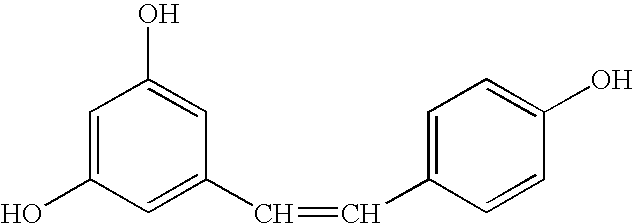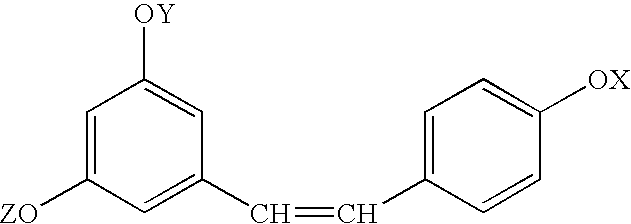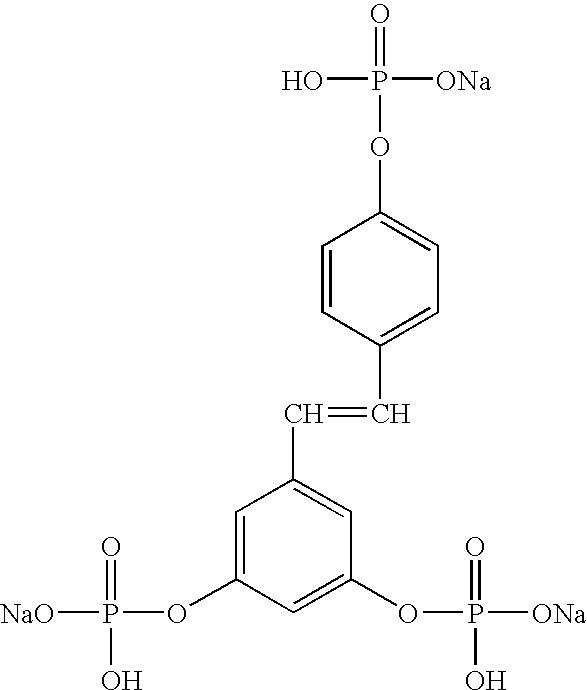Cosmetic methods and compositions for repairing human skin
- Summary
- Abstract
- Description
- Claims
- Application Information
AI Technical Summary
Benefits of technology
Problems solved by technology
Method used
Image
Examples
example 1
Demonstration of the Synergistic Effects of OGG1 Enzyme and Resveratrol in Protecting Cells from UVB Induced Toxicity
[0068]In this test, human keratinocyte cells were challenged with UVB, following treatments with ROXISOMES™ (liposome encapsulated OGG1 enzyme from AGI Dermatics) alone, resveratrol alone, or the combination of ROXISOMES™ and resveratrol. The keratinocytes survival rates were then compared to see the effects of different treatments on the kertinocytes viability.
[0069]Specifically, normal human keratinocytes were cultured in Epilife Medium with Human Keratinocyte Growth Supplement. The cells were sub-cultured into 96-well plates. A first set of plates were treated overnight with resveratrol at testing concentrations of 0 (which was used as the control or base measurement), 1, 5, and 25 μM, respectively. A second set of plates were treated with ROXISOMES™ at 0% (which was used as the control or base measurement), 0.04%, 0.2%, and 1%, respectively. A third set of plates ...
example 2
Demonstration of the Synergistic Effects of T4N5 Enzyme and Resveratrol in Protecting Cells from UVB Induced Toxicity
[0073]In this test, human keratinocyte cells were challenged with UVB, following treatments with T4 endonuclease V (T4N5) enzyme alone, resveratrol alone, or the combination of T4N5 enzyme and resveratrol. The keratinocytes survival rates were then compared to see the effects of different treatments on the kertinocytes viability.
[0074]Specifically, normal human keratinocytes were cultured in Epilife Medium with Human Keratinocyte Growth Supplement. The cells were sub-cultured into 96-well plates. A first set of plates were treated with resveratrol at testing concentrations of 0 (which was used as the control or base measurement), 1, 5, and 25 μM, respectively. A second set of plates were treated with T4N5 enzyme at 0% (which was used as the control or base measurement), 0.04%, 0.2%, and 1%, respectively. A third set of plates were treated with a combination of resvera...
example 3
Demonstration of the Synergistic Effects of T4N5 Enzyme and Resveratrol Triphosphate in Protecting Cells from UVB Induced Toxicity
[0077]In this test, human keratinocyte cells were challenged with UVB, following treatments with T4 endonuclease V (T4N5) enzyme alone, resveratrol triphosphate alone, or the combination of T4N5 enzyme and resveratrol triphosphate. The keratinocytes survival rates were then compared to see the effects of different treatments on the kertinocytes viability.
[0078]Specifically, normal human keratinocytes were cultured in Epilife Medium with Human Keratinocyte Growth Supplement. The cells were sub-cultured into 96-well plates. A first set of plates were treated with resveratrol triphosphate at testing concentrations of 0 (which was used as the control or base measurement), 1, 5, and 25 μM, respectively. A second set of plates were treated with T4N5 enzyme at 0% (which was used as the control or base measurement), 0.04%, 0.2%, and 1%, respectively. A third set ...
PUM
| Property | Measurement | Unit |
|---|---|---|
| Time | aaaaa | aaaaa |
| Fraction | aaaaa | aaaaa |
| Fraction | aaaaa | aaaaa |
Abstract
Description
Claims
Application Information
 Login to View More
Login to View More - R&D
- Intellectual Property
- Life Sciences
- Materials
- Tech Scout
- Unparalleled Data Quality
- Higher Quality Content
- 60% Fewer Hallucinations
Browse by: Latest US Patents, China's latest patents, Technical Efficacy Thesaurus, Application Domain, Technology Topic, Popular Technical Reports.
© 2025 PatSnap. All rights reserved.Legal|Privacy policy|Modern Slavery Act Transparency Statement|Sitemap|About US| Contact US: help@patsnap.com



